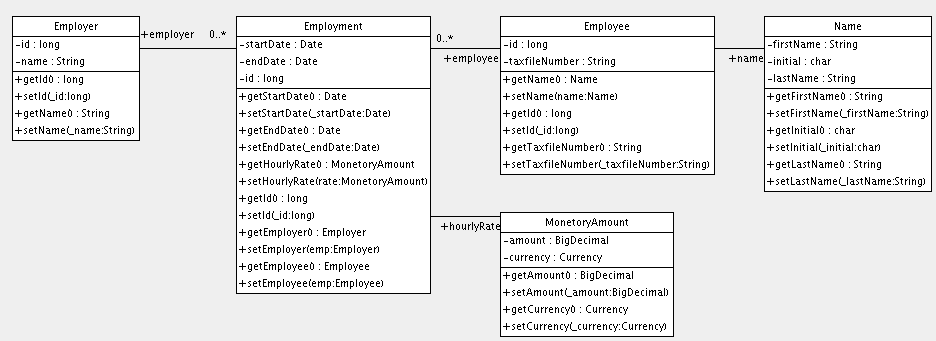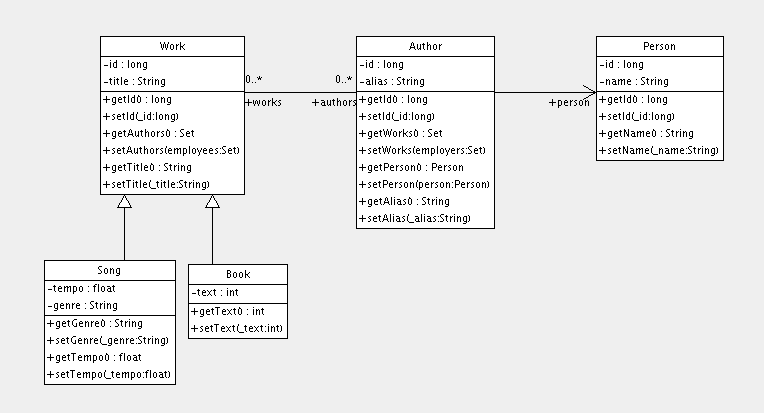Глава 25. Пример. Различные отображения
Оглавление- 25.1. Работодатель/Работник
- 25.2. Автор/Работа
- 25.3. Клиент/Заказ/Товар
- 25.4. Различные примеры отображений
В этих главах рассматриваются некоторые более сложные ассоциации отображения.
25.1. Работодатель/Работник (Employer/Employee)
Следующая модель отношений между работодателем Employer и работником Employee
использует класс сущности Employment для представления ассоциации. Вы можете сделать это,
когда может быть более одного периода работы для тех же двух сторон. Компоненты используются
для моделирования денежных значений и имён сотрудников.

Вот возможное отображение:
<hibernate-mapping>
<class name="Employer" table="employers">
<id name="id">
<generator class="sequence">
<param name="sequence">employer_id_seq</param>
</generator>
</id>
<property name="name"/>
</class>
<class name="Employment" table="employment_periods">
<id name="id">
<generator class="sequence">
<param name="sequence">employment_id_seq</param>
</generator>
</id>
<property name="startDate" column="start_date"/>
<property name="endDate" column="end_date"/>
<component name="hourlyRate" class="MonetaryAmount">
<property name="amount">
<column name="hourly_rate" sql-type="NUMERIC(12, 2)"/>
</property>
<property name="currency" length="12"/>
</component>
<many-to-one name="employer" column="employer_id" not-null="true"/>
<many-to-one name="employee" column="employee_id" not-null="true"/>
</class>
<class name="Employee" table="employees">
<id name="id">
<generator class="sequence">
<param name="sequence">employee_id_seq</param>
</generator>
</id>
<property name="taxfileNumber"/>
<component name="name" class="Name">
<property name="firstName"/>
<property name="initial"/>
<property name="lastName"/>
</component>
</class>
</hibernate-mapping>
Вот схема таблицы, сгенерированная SchemaExport.
create table employers (
id BIGINT not null,
name VARCHAR(255),
primary key (id)
)
create table employment_periods (
id BIGINT not null,
hourly_rate NUMERIC(12, 2),
currency VARCHAR(12),
employee_id BIGINT not null,
employer_id BIGINT not null,
end_date TIMESTAMP,
start_date TIMESTAMP,
primary key (id)
)
create table employees (
id BIGINT not null,
firstName VARCHAR(255),
initial CHAR(1),
lastName VARCHAR(255),
taxfileNumber VARCHAR(255),
primary key (id)
)
alter table employment_periods
add constraint employment_periodsFK0 foreign key (employer_id) references employers
alter table employment_periods
add constraint employment_periodsFK1 foreign key (employee_id) references employees
create sequence employee_id_seq
create sequence employment_id_seq
create sequence employer_id_seq
25.2. Автор/Работа (Author/Work)
Рассмотрим следующую модель отношений между Work (Работой), Author (Автором)
и Person (Персоной). В этом примере отношения между Work 4
и Author представлены как ассоциация «многие-ко-многим»,
а связь между Author и Person представляется как ассоциация
«один-ко-одному». Другая возможность заключалась бы в том, чтобы Author
расширил Person.

Следующий документ отображения правильно отражает эти отношения:
<hibernate-mapping>
<class name="Work" table="works" discriminator-value="W">
<id name="id" column="id">
<generator class="native"/>
</id>
<discriminator column="type" type="character"/>
<property name="title"/>
<set name="authors" table="author_work">
<key column name="work_id"/>
<many-to-many class="Author" column name="author_id"/>
</set>
<subclass name="Book" discriminator-value="B">
<property name="text"/>
</subclass>
<subclass name="Song" discriminator-value="S">
<property name="tempo"/>
<property name="genre"/>
</subclass>
</class>
<class name="Author" table="authors">
<id name="id" column="id">
<!-- The Author must have the same identifier as the Person -->
<generator class="assigned"/>
</id>
<property name="alias"/>
<one-to-one name="person" constrained="true"/>
<set name="works" table="author_work" inverse="true">
<key column="author_id"/>
<many-to-many class="Work" column="work_id"/>
</set>
</class>
<class name="Person" table="persons">
<id name="id" column="id">
<generator class="native"/>
</id>
<property name="name"/>
</class>
</hibernate-mapping>
В этом отображении имеется четыре таблицы: works, authors
и persons, соответственно, содержат данные о работе, авторе и персонах.
author_work — это таблица ассоциаций, связывающая авторов с работами.
Вот схема таблицы, созданная SchemaExport:
create table works (
id BIGINT not null generated by default as identity,
tempo FLOAT,
genre VARCHAR(255),
text INTEGER,
title VARCHAR(255),
type CHAR(1) not null,
primary key (id)
)
create table author_work (
author_id BIGINT not null,
work_id BIGINT not null,
primary key (work_id, author_id)
)
create table authors (
id BIGINT not null generated by default as identity,
alias VARCHAR(255),
primary key (id)
)
create table persons (
id BIGINT not null generated by default as identity,
name VARCHAR(255),
primary key (id)
)
alter table authors
add constraint authorsFK0 foreign key (id) references persons
alter table author_work
add constraint author_workFK0 foreign key (author_id) references authors
alter table author_work
add constraint author_workFK1 foreign key (work_id) references works
25.3. Клиент / Заказ / Товар (Customer / Order / Product)
В этом разделе мы рассмотрим модель взаимоотношений между Customer,
Order, LineItemи Product. Между Customer
и Order существует связь «один-ко-многим», но как вы можете
представить Order/LineItem/Product? В этом примере
LineItem отображается как класс ассоциации, представляющий связь многие-ко-многими между
Order и Product. В Hibernate это называется составным элементом.

Документ сопоставления будет выглядеть следующим образом:
<hibernate-mapping>
<class name="Customer" table="customers">
<id name="id">
<generator class="native"/>
</id>
<property name="name"/>
<set name="orders" inverse="true">
<key column="customer_id"/>
<one-to-many class="Order"/>
</set>
</class>
<class name="Order" table="orders">
<id name="id">
<generator class="native"/>
</id>
<property name="date"/>
<many-to-one name="customer" column="customer_id"/>
<list name="lineItems" table="line_items">
<key column="order_id"/>
<list-index column="line_number"/>
<composite-element class="LineItem">
<property name="quantity"/>
<many-to-one name="product" column="product_id"/>
</composite-element>
</list>
</class>
<class name="Product" table="products">
<id name="id">
<generator class="native"/>
</id>
<property name="serialNumber"/>
</class>
</hibernate-mapping>
customers, orders, line_items и products содержат
заказчиков, заказы, позицию заказа и данные продукта соответственно. line_items также
действует как таблица ассоциации, связывающая заказы с товарами.
create table customers (
id BIGINT not null generated by default as identity,
name VARCHAR(255),
primary key (id)
)
create table orders (
id BIGINT not null generated by default as identity,
customer_id BIGINT,
date TIMESTAMP,
primary key (id)
)
create table line_items (
line_number INTEGER not null,
order_id BIGINT not null,
product_id BIGINT,
quantity INTEGER,
primary key (order_id, line_number)
)
create table products (
id BIGINT not null generated by default as identity,
serialNumber VARCHAR(255),
primary key (id)
)
alter table orders
add constraint ordersFK0 foreign key (customer_id) references customers
alter table line_items
add constraint line_itemsFK0 foreign key (product_id) references products
alter table line_items
add constraint line_itemsFK1 foreign key (order_id) references orders
25.4. Различные примеры отображений
Эти примеры доступны из набора тестов Hibernate. Вы найдёте много других полезных примеров
отображений в папке test дистрибутива Hibernate.
25.4.1. "Типизированная" ассоциация «один-к-одному»
<class name="Person">
<id name="name"/>
<one-to-one name="address"
cascade="all">
<formula>name</formula>
<formula>'HOME'</formula>
</one-to-one>
<one-to-one name="mailingAddress"
cascade="all">
<formula>name</formula>
<formula>'MAILING'</formula>
</one-to-one>
</class>
<class name="Address" batch-size="2"
check="addressType in ('MAILING', 'HOME', 'BUSINESS')">
<composite-id>
<key-many-to-one name="person"
column="personName"/>
<key-property name="type"
column="addressType"/>
</composite-id>
<property name="street" type="text"/>
<property name="state"/>
<property name="zip"/>
</class>
25.4.2. Пример составного ключа
<class name="Customer">
<id name="customerId"
length="10">
<generator class="assigned"/>
</id>
<property name="name" not-null="true" length="100"/>
<property name="address" not-null="true" length="200"/>
<list name="orders"
inverse="true"
cascade="save-update">
<key column="customerId"/>
<index column="orderNumber"/>
<one-to-many class="Order"/>
</list>
</class>
<class name="Order" table="CustomerOrder" lazy="true">
<synchronize table="LineItem"/>
<synchronize table="Product"/>
<composite-id name="id"
class="Order$Id">
<key-property name="customerId" length="10"/>
<key-property name="orderNumber"/>
</composite-id>
<property name="orderDate"
type="calendar_date"
not-null="true"/>
<property name="total">
<formula>
( select sum(li.quantity*p.price)
from LineItem li, Product p
where li.productId = p.productId
and li.customerId = customerId
and li.orderNumber = orderNumber )
</formula>
</property>
<many-to-one name="customer"
column="customerId"
insert="false"
update="false"
not-null="true"/>
<bag name="lineItems"
fetch="join"
inverse="true"
cascade="save-update">
<key>
<column name="customerId"/>
<column name="orderNumber"/>
</key>
<one-to-many class="LineItem"/>
</bag>
</class>
<class name="LineItem">
<composite-id name="id"
class="LineItem$Id">
<key-property name="customerId" length="10"/>
<key-property name="orderNumber"/>
<key-property name="productId" length="10"/>
</composite-id>
<property name="quantity"/>
<many-to-one name="order"
insert="false"
update="false"
not-null="true">
<column name="customerId"/>
<column name="orderNumber"/>
</many-to-one>
<many-to-one name="product"
insert="false"
update="false"
not-null="true"
column="productId"/>
</class>
<class name="Product">
<synchronize table="LineItem"/>
<id name="productId"
length="10">
<generator class="assigned"/>
</id>
<property name="description"
not-null="true"
length="200"/>
<property name="price" length="3"/>
<property name="numberAvailable"/>
<property name="numberOrdered">
<formula>
( select sum(li.quantity)
from LineItem li
where li.productId = productId )
</formula>
</property>
</class>
25.4.3. «Многие-ко-многим» с общим атрибутом составного ключа
<class name="User" table="`User`">
<composite-id>
<key-property name="name"/>
<key-property name="org"/>
</composite-id>
<set name="groups" table="UserGroup">
<key>
<column name="userName"/>
<column name="org"/>
</key>
<many-to-many class="Group">
<column name="groupName"/>
<formula>org</formula>
</many-to-many>
</set>
</class>
<class name="Group" table="`Group`">
<composite-id>
<key-property name="name"/>
<key-property name="org"/>
</composite-id>
<property name="description"/>
<set name="users" table="UserGroup" inverse="true">
<key>
<column name="groupName"/>
<column name="org"/>
</key>
<many-to-many class="User">
<column name="userName"/>
<formula>org</formula>
</many-to-many>
</set>
</class>
25.4.4. Контекстная дискриминация
<class name="Person"
discriminator-value="P">
<id name="id"
column="person_id"
unsaved-value="0">
<generator class="native"/>
</id>
<discriminator
type="character">
<formula>
case
when title is not null then 'E'
when salesperson is not null then 'C'
else 'P'
end
</formula>
</discriminator>
<property name="name"
not-null="true"
length="80"/>
<property name="sex"
not-null="true"
update="false"/>
<component name="address">
<property name="address"/>
<property name="zip"/>
<property name="country"/>
</component>
<subclass name="Employee"
discriminator-value="E">
<property name="title"
length="20"/>
<property name="salary"/>
<many-to-one name="manager"/>
</subclass>
<subclass name="Customer"
discriminator-value="C">
<property name="comments"/>
<many-to-one name="salesperson"/>
</subclass>
</class>
25.4.5. Ассоциации по альтернативным ключам
<class name="Person">
<id name="id">
<generator class="hilo"/>
</id>
<property name="name" length="100"/>
<one-to-one name="address"
property-ref="person"
cascade="all"
fetch="join"/>
<set name="accounts"
inverse="true">
<key column="userId"
property-ref="userId"/>
<one-to-many class="Account"/>
</set>
<property name="userId" length="8"/>
</class>
<class name="Address">
<id name="id">
<generator class="hilo"/>
</id>
<property name="address" length="300"/>
<property name="zip" length="5"/>
<property name="country" length="25"/>
<many-to-one name="person" unique="true" not-null="true"/>
</class>
<class name="Account">
<id name="accountId" length="32">
<generator class="uuid"/>
</id>
<many-to-one name="user"
column="userId"
property-ref="userId"/>
<property name="type" not-null="true"/>
</class>